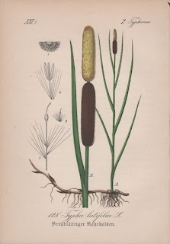Brenda Groth wrote:
i have read that cattails are good food, and we have tons and tons of them, but I haven't eaten them YET....but now i'll give them a try..
well when they are at the edible stage again..right now they are putting on their tops..
"You can clip off and eat the male portions of the immature, green, flower head. Steam or simmer it for ten minutes. It tastes vaguely like its distant relative, corn, and there ís even a central cob-like core. Because it's dry, serve it with a topping of sauce, seasoned oil, or butter. Sometimes I also gnaw on the cooked female portions, but thereís very little to them. It ís easier to remove the flesh from the woody core, if desired, after steaming. This adds a rich, filling element to any dish, and it's one of the best wild vegetarian sources of protein, unsaturated fat, and calories. It also provides beta-carotene and minerals."
http://www.wildmanstevebrill.com/Plants.Folder/Cattails.html 







